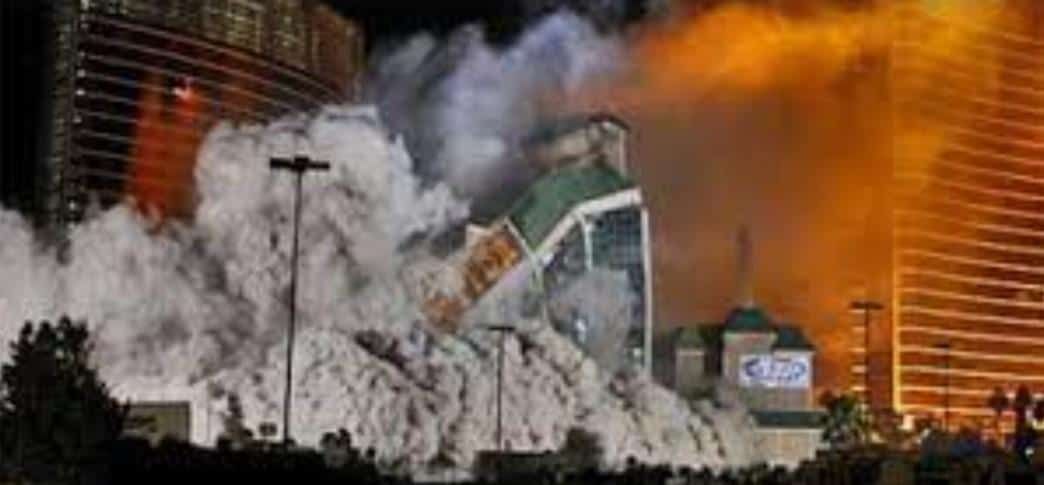
Another One Bites the Dust!
Las Vegas has not frequently imploded its casinos. However, in the past, some older casinos and hotels have been imploded for various reasons.
Outdated Facilities, Economic considerations because demolishing underperforming properties is sometimes better value than bringing an aging building up to code or current building regulations. Or perhaps their reputation was damaged by organized crime but either way they make for a fantastic public spectacle.
It is essential to note that the practice of casino implosions has become less common over the years, as Las Vegas now focuses more on resort expansions, renovations, and adapting to changing consumer demands rather than outright demolitions and Vegas now attributes a higher value to it’s historic sites as America realises it’s past is its legacy and only adds to its allure.

The New Frontier Meets It's Last
Las Vegas, often dubbed the entertainment capital of the world, has witnessed the rise and fall of numerous iconic establishments throughout its history. Among these legendary landmarks, The New Frontier holds a special place. In this article, we will delve into the origins of The New Frontier Las Vegas, tracing its history through various owners and uncovering any dark secrets hidden within its walls. Join us on a journey through time as we explore the captivating story of this remarkable establishment.
The Birth of The New Frontier
The New Frontier Las Vegas first came into existence on October 30, 1942. Originally named the Last Frontier, and before that, the Pair O’ Dice casino in 1931, it was situated on what is now the famous Las Vegas Strip. R.E. Griffith, a renowned businessman and entrepreneur, constructed the hotel and casino. The Last Frontier quickly became a popular attraction for locals and tourists alike, drawing crowds with its Western-themed ambience and exciting gaming options.
Early Years and Notable Owners
In 1955, the hotel underwent a significant transformation and rebranded as The New Frontier. This change was accompanied by various renovations and expansions, propelling The New Frontier to new heights of success. Over the years, the establishment changed hands several times, with each owner leaving their mark on the property.
One of the notable owners was Howard Hughes, the legendary billionaire, aviator, and filmmaker. Hughes acquired The New Frontier in 1967 and introduced various modernizations to the resort. His ownership brought a touch of glamour and allure to the property, attracting high-profile guests worldwide.
Expansion and Renovations
Throughout the 1970s and 1980s, The New Frontier underwent numerous expansions and renovations, solidifying its position as one of Las Vegas’s premier destinations. The property expanded its gaming floor, added new entertainment venues, and upgraded its hotel facilities. These efforts ensured that The New Frontier remained a favourite among visitors seeking excitement and luxury in the heart of Las Vegas.
The Disappearance of Louis “Benny” Binion:
Binion was a prominent Las Vegas casino owner who was found dead in his hotel room at the Frontier in 1989. His death was ruled a suicide, but some people believe that he was murdered.
The mob connections of the hotel’s owners: The New Frontier was owned by a number of different people over the years, some of whom had ties to organized crime. In the 1950s, the hotel was owned by Moe Dalitz, a known mobster who was involved in the Cleveland Mafia.
The Decline and Demolition
Despite its rich history and enduring popularity, The New Frontier faced challenges in the late 20th century. Increased competition from newer, more extravagant resorts on the Strip, combined with changing market dynamics, led to a decline in its fortunes. The New Frontier ultimately closed its doors on July 16, 2007, marking the end of an era.
In the years following its closure, plans for revitalizing or redeveloping The New Frontier emerged but never came to fruition. Eventually, the decision was made to demolish the iconic resort. The demolition took place on November 13, 2007, making way for future developments in the ever-evolving landscape of Las Vegas.
The New Frontier Las Vegas was a legendary establishment that played a significant role in the city’s history. From its humble beginnings as the Last Frontier to its transformation into The New Frontier, the resort attracted visitors from far and wide, leaving an indelible mark on the Las Vegas Strip. While its dark secrets and controversies may remain shrouded in mystery, the memories of The New Frontier continue to captivate those with an interest in the city’s vibrant past.
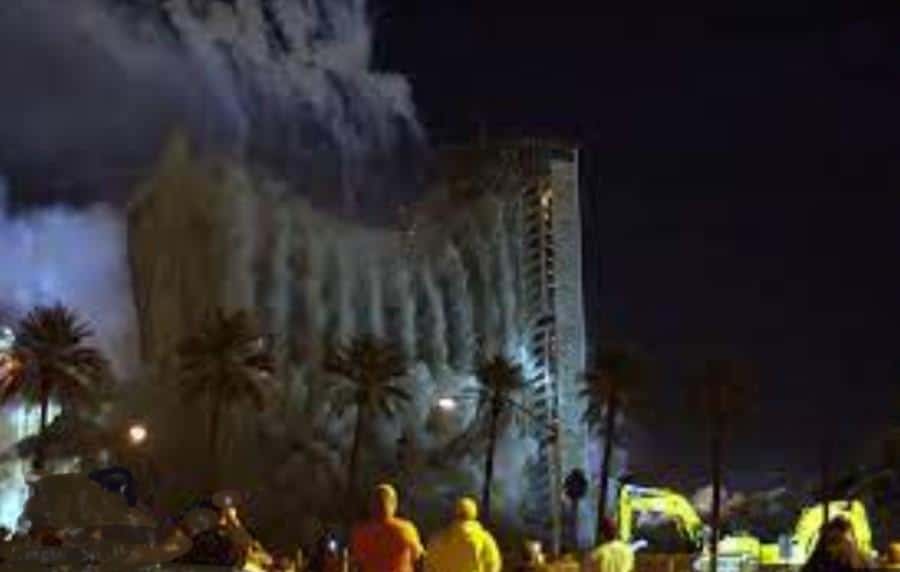
The Stardust Supernovae
The Stardust History And Secrets
Las Vegas, the glittering oasis in the Nevada desert, has witnessed the rise and fall of numerous legendary establishments. Among them, one casino-hotel stood out for its grandeur and storied past: The Stardust. This article takes you on a journey through the fascinating beginnings, glorious history, notorious owners, dark secrets, and its eventual implosion, leaving an indelible mark on Las Vegas’s landscape.
The Stardust wasn’t just a casino; it was a luxurious hotel that redefined hospitality. With its modern amenities, glamorous showrooms, and top-notch services, it attracted celebrities, high-rollers, and tourists from all walks of life. The famous Lido de Paris show and the iconic Stardust sign became emblematic of the Las Vegas Strip.
The Notorious Owners and Their Impact
Throughout its existence, the Stardust witnessed ownership changes, falling into the hands of various crime syndicates. The likes of Frank ‘Lefty’ Rosenthal and Anthony Spilotro were among the infamous personalities associated with the casino. Their influence on the casino’s operations and the city’s history was both mesmerizing and menacing.
The Stardust’s Downfall: The Dark Secrets Unveiled
Behind the glitz and glamour, the Stardust concealed a web of dark secrets. From organized crime connections to money laundering allegations, the casino’s reputation began to tarnish. The Nevada Gaming Control Board launched investigations, threatening to bring the entire empire crashing down.
As the Stardust’s glory reached its peak, a web of dark secrets began to surface, casting a shadow over its illustrious reputation. Behind the dazzling lights and extravagant shows, the casino had deep ties to organized crime, leading to a series of investigations that would eventually unravel the casino’s fate.
Connections to the Mob
One of the most troubling revelations was the Stardust’s association with the mob. Frank ‘Lefty’ Rosenthal, a well-known figure in the criminal underworld, was allegedly the mastermind behind the casino’s operations. As the casino manager and later as the entertainment director, Rosenthal had an iron grip on the Stardust’s day-to-day affairs. His connections to the Chicago Outfit and other crime families allowed him to run the casino with an iron fist.
Target of Law Enforcement
The illicit activities within the Stardust did not go unnoticed. The Nevada Gaming Control Board (NGCB) launched an extensive investigation to uncover the truth behind the casino’s operations. The NGCB’s inquiries, along with cooperation from federal authorities, aimed to bring those responsible to justice and to protect the integrity of the state’s gaming industry.
Controversial Ownership
The ownership of the Stardust was marred by controversy as well. While the mob maintained significant influence, other legitimate businessmen were also involved in the casino’s ownership. This complex web of ownership made it challenging to discern the true power players behind the scenes.
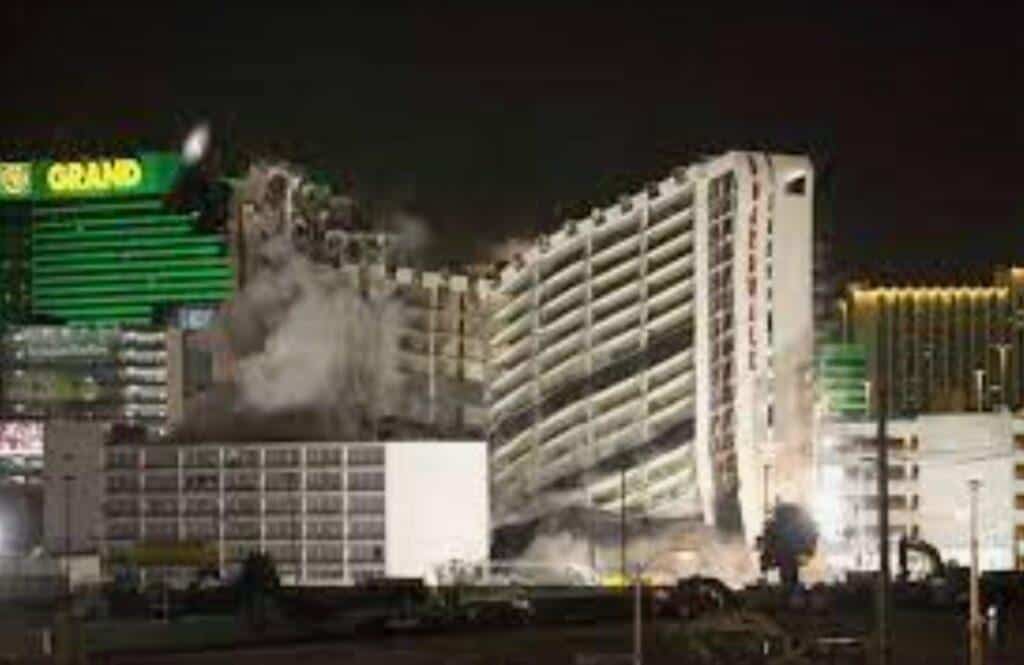
The Boardwalk Implosion
The Boardwalk Casino in Las Vegas, once a glittering icon of the city’s vibrant entertainment industry, is shrouded in a fascinating history that encompasses its remarkable rise, numerous owners, and a collection of dark secrets that eventually led to its dramatic implosion. Join us as we delve into the captivating story of The Boardwalk Casino and uncover the mysteries that surround this enigmatic establishment.
The Beginnings
The Boardwalk Casino first opened its doors to the public in 1966, during the golden era of Las Vegas. Located on the famous Las Vegas Strip, the casino was the brainchild of visionary entrepreneur Richard Holloway. Holloway envisioned The Boardwalk as a dazzling destination, combining the allure of a carnival atmosphere with the excitement of a high-end casino.
Holloway’s concept proved to be a stroke of genius, and The Boardwalk quickly became a favourite among locals and tourists alike. Its signature feature was a wooden boardwalk, reminiscent of the Atlantic City boardwalk, adorned with arcade games, amusement rides, and street performers, making it a one-of-a-kind entertainment hub in the city.
Ownership Changes
Despite its early success, The Boardwalk faced financial difficulties over the years, leading to a series of ownership changes. Richard Holloway’s initial company went bankrupt in 1974, prompting the casino’s sale to a group of investors. This pattern of successive ownership changes continued, with various corporations and individuals trying their luck at running the iconic establishment.
In 1998, the MGM Resorts International, a prominent player in the Las Vegas gaming industry, acquired The Boardwalk Casino in a bid to expand its portfolio and solidify its presence on the Strip. For a brief period, The Boardwalk experienced a resurgence under MGM’s management, boasting newly renovated facilities and a revitalized image.
The Dark Secrets
Beneath its glitzy exterior, The Boardwalk harboured a collection of dark secrets that eventually came to light. Rumours circulated about illegal activities, including money laundering and organized crime connections, which tainted the casino’s reputation. Allegations of corruption and ties to criminal networks plagued the establishment, putting it under scrutiny from law enforcement agencies and regulatory bodies.
In an attempt to salvage its reputation, MGM Resorts International initiated internal investigations and implemented stricter compliance measures. However, the shadow of its tainted past lingered, affecting both the casino’s operations and public perception.
The Implosion
Despite efforts to revive its image, The Boardwalk’s turbulent history caught up with it. In 2006, the MGM Resorts International made a controversial decision to implode The Boardwalk Casino. The iconic establishment, once a symbol of Las Vegas’ glory days, was reduced to rubble in a controlled demolition. The implosion marked the end of an era, bidding farewell to a casino that had played a significant role in the city’s history.
The Boardwalk Casino’s story is one of triumphs and tribulations, of soaring success and dark secrets that ultimately led to its downfall. While its implosion marked the end of a storied era, the legacy of The Boardwalk lives on as a reminder of the ever-changing landscape of Las Vegas and the captivating allure of the city’s entertainment industry. As the Strip continues to evolve, new chapters in the history of gaming and entertainment will be written, ensuring that the spirit of Las Vegas lives on in the hearts of those who experience its magic.
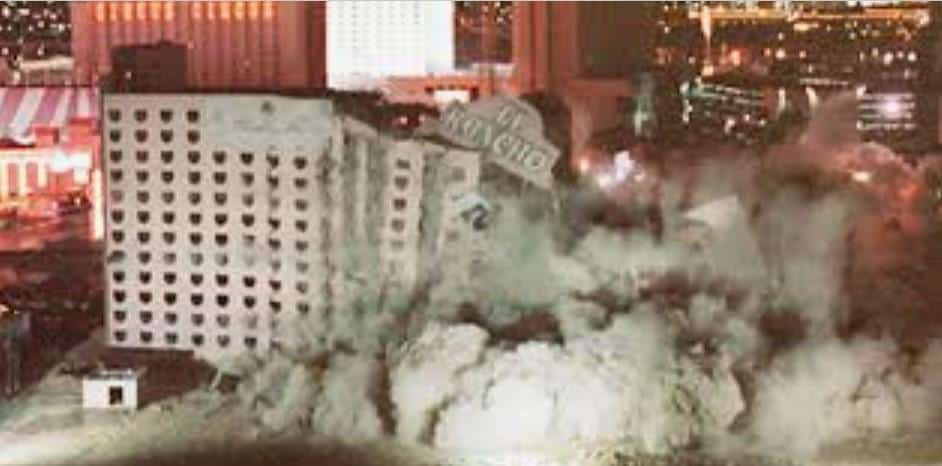
The El Rancho Implosion Implosion Las Vegas
The El Rancho, a historic casino that once graced the iconic Las Vegas Strip, holds a captivating tale of its rise to fame, a rollercoaster history with multiple owners, and a collection of mysterious dark secrets that ultimately led to its dramatic implosion. Join us as we embark on a journey to explore the intriguing story of The El Rancho Casino and uncover the enigmatic secrets that surround its legacy.
The Beginnings
In 1941, The El Rancho opened its doors as the first-ever resort on the famous Las Vegas Strip. Established by Thomas Hull, a visionary businessman with a passion for entertainment and gambling, the casino boasted a Western-themed architecture, complete with a façade that resembled an old Western town.
The El Rancho quickly became a hit with visitors, offering a unique blend of casino gaming, live entertainment, and a taste of the Wild West. Its prime location on the Strip attracted a steady stream of tourists, establishing The El Rancho as a prominent fixture in the burgeoning Las Vegas entertainment scene.
Ownership Changes
Over the years, The El Rancho experienced numerous changes in ownership. Thomas Hull sold the casino to a group of investors in the 1950s, and it changed hands multiple times thereafter. Each new owner brought their ideas and management styles to the establishment, leading to various renovations and expansions.
While some ownership transitions brought success and prosperity, others were plagued by financial difficulties and mismanagement. These fluctuations in ownership contributed to the casino’s unstable financial situation, which set the stage for its eventual downfall.
The Dark Secrets
Amidst The El Rancho’s glamorous exterior lurked a series of dark secrets that gradually emerged over time. Rumours circulated about the casino’s alleged ties to organized crime, with whispers of illicit activities taking place within its walls. Money laundering, illegal gambling operations, and connections to notorious figures clouded the casino’s reputation, drawing the attention of law enforcement and regulatory agencies.
Despite attempts by certain owners to distance themselves from any illegal dealings, the rumours persisted, casting a shadow over The El Rancho’s legacy and hindering its potential for growth and reinvention.
The Implosion
In 1992, faced with mounting financial troubles and a tarnished reputation, The El Rancho Casino met a fate similar to many other ageing establishments on the Strip – implosion. In a bittersweet spectacle, the iconic casino was brought down in a controlled demolition, marking the end of an era.
The implosion opened up the space for future developments, as newer, more opulent resorts took its place on the ever-evolving Las Vegas Strip. The El Rancho’s legacy, however, lives on in the memories of those who once walked its halls and indulged in its entertainment offerings.
The El Rancho Casino’s story is one of ambition, fame, and secrecy, woven into the fabric of Las Vegas’ history. As we reflect on its fascinating beginnings, turbulent history with multiple owners, and the shadows of dark secrets, we gain insight into the complexities of the gaming industry and the allure of Las Vegas as the entertainment capital of the world. The implosion of The El Rancho, while a moment of finality, also signifies the constant metamorphosis of the city’s landscape, forever reinventing itself to capture the hearts and imaginations of millions of visitors from around the globe.

The Hacienda Casino Implosion
The Hacienda Casino, an iconic establishment that once stood proudly on the illustrious Las Vegas Strip, holds a captivating history of its rise to fame, a rollercoaster journey with various owners, and a web of mysterious dark secrets that ultimately led to its dramatic implosion. Join us as we embark on a journey to uncover the intriguing story of The Hacienda Casino and delve into the enigmatic secrets that shroud its legacy.
The Beginnings
In 1956, The Hacienda Casino opened its doors as a grand hotel and casino, heralding a new era of luxury and entertainment in Las Vegas. With its distinctive Spanish hacienda-inspired architecture and lavish amenities, the resort quickly became a favourite among high-rolling gamblers and tourists seeking the glitz and glamour of Sin City.
Managed by the renowned Moe Dalitz, a key figure in the city’s gaming industry, The Hacienda boasted an extravagant casino floor, top-notch entertainment shows, and exquisite dining experiences. Its prime location on the Strip further solidified its status as a premier destination for visitors from all walks of life.
Ownership Changes
The Hacienda’s journey was marked by a series of ownership changes. Moe Dalitz, along with his associates, ran the casino for several successful years, establishing its reputation as a must-visit venue in Las Vegas. However, as time passed, ownership of The Hacienda transitioned to various corporations and individuals, each leaving their mark on the resort.
Some owners sought to expand and modernize the casino, introducing new attractions and amenities, while others struggled to maintain its former glory. Despite the changes in management, The Hacienda’s allure endured, drawing patrons from around the world to experience the excitement of the Las Vegas Strip.
The Dark Secrets
Beneath the glimmering facade of The Hacienda Casino, a veil of dark secrets loomed. Rumours circulated about alleged ties to organized crime, hinting at hidden connections and illicit activities within the casino’s walls. These rumours cast shadows over the resort’s reputation, leading to investigations by law enforcement agencies and regulatory bodies.
While some allegations were substantiated, others remained enigmatic and inconclusive, leaving room for speculation and intrigue. The Hacienda’s association with figures reputed to have links to criminal networks fueled the whispers and contributed to the casino’s eventual downfall.
The Implosion
In 1996, after battling financial difficulties and a tarnished reputation, The Hacienda Casino faced the same fate as several other ageing establishments on the Strip – implosion. The once-proud resort was brought down in a controlled demolition, making way for a new chapter in the ever-changing landscape of Las Vegas.
The implosion marked the end of an era, bidding farewell to a casino that had played a significant role in shaping the city’s entertainment history. While the physical structure was reduced to rubble, the memories and stories of The Hacienda Casino continued to echo through the annals of Las Vegas lore.
The Hacienda Casino’s tale is one of grandeur, transitions, and shadows that dance on the edge of reality and myth. As we explore its fascinating beginnings, tumultuous history with various owners, and the mysteries of dark secrets, we gain insight into the complex world of Las Vegas gaming and entertainment.
The implosion of The Hacienda symbolizes the perpetual evolution of the Las Vegas Strip, where old gives way to new, and the spirit of innovation and excitement endures. The legacy of The Hacienda lives on in the hearts of those who experienced its magic, forever etched in the storied tapestry of Las Vegas’ illustrious past.
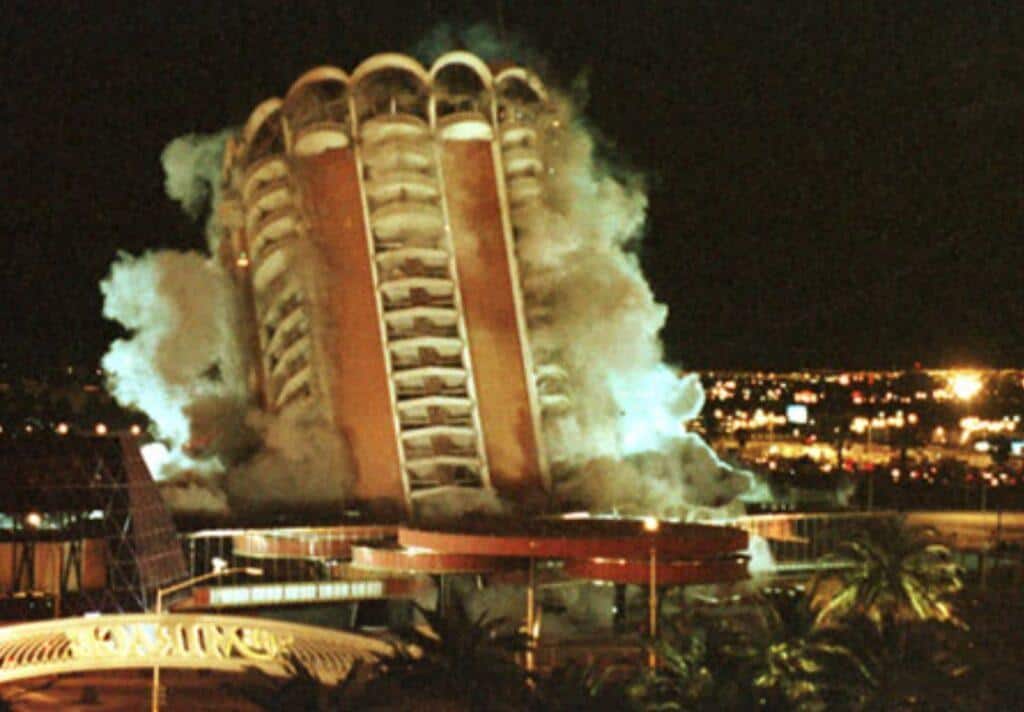
The Sands Casino Implosion Las Vegas - The Return to the Desert from Which It Came
The Sands Casino, a legendary landmark that once adorned the glitzy Las Vegas Strip, holds a captivating history of its rise to fame, a tumultuous journey under various owners, and a web of mysterious dark secrets that eventually led to its dramatic implosion. Join us as we delve into the intriguing story of The Sands Casino and uncover the enigmatic secrets that surround its legacy.
The Beginnings
In 1952, The Sands Casino opened its doors as a lavish resort, signalling a new era of sophistication and entertainment in Las Vegas. Led by the visionary entrepreneur and notorious mobster, Benjamin “Bugsy” Siegel, and later overseen by his associates, the resort was designed to exude luxury and opulence.
The Sands quickly gained fame for its high-end casino, glamorous entertainment shows featuring renowned stars like Frank Sinatra, Dean Martin, and Sammy Davis Jr., and its exclusive, star-studded clientele. With its prime location on the Strip, The Sands became a symbol of Las Vegas’ emergence as an entertainment capital.
Ownership Changes
After Bugsy Siegel’s untimely death in 1947, the ownership of The Sands Casino passed into the hands of other organized crime figures, including the infamous Meyer Lansky. However, as the influence of organized crime waned in the late 1960s, the casino’s ownership changed hands once again, transitioning to legitimate corporations.
Various reputable corporations and investors tried their hand at running The Sands, each attempting to maintain the casino’s allure while adapting to the ever-changing landscape of Las Vegas entertainment. Despite the efforts of new owners, The Sands faced increasing competition from the newer mega-resorts that began to dominate the Strip.
The Dark Secrets
Throughout its heyday, The Sands Casino was rumoured to have deep ties to organized crime, with allegations of money laundering and connections to illicit activities. These rumours cast a shadow over the resort’s glamorous image, attracting attention from law enforcement agencies and the government.
While some of these rumours were substantiated, others remained shrouded in mystery, giving rise to a cloud of intrigue that surrounded The Sands. Despite its status as a popular destination, the casino’s reputation became increasingly tarnished due to these associations.
The Implosion
In 1996, facing financial struggles and the inability to compete with newer and more extravagant resorts, The Sands Casino met a fate that had befallen several of its predecessors – implosion. In a controlled demolition, the once-proud establishment was reduced to rubble, making way for new developments on the ever-evolving Las Vegas Strip.
The implosion marked the end of an era, bidding farewell to a casino that had played a pivotal role in shaping the city’s entertainment scene. While the physical structure was gone, the memories and legends of The Sands Casino continued to echo through the history of Las Vegas.
The Sands Casino’s story is one of glamour, transitions, and the shadows of dark secrets that shaped its fate. As we explore its fascinating beginnings, turbulent history with various owners, and the enigmatic world of dark rumours, we gain insight into the complex landscape of Las Vegas gaming and entertainment.
The implosion of The Sands symbolizes the constant evolution of the Las Vegas Strip, where old gives way to new, and the spirit of reinvention persists. The legacy of The Sands lives on in the memories of those who experienced its allure, forever etched in the chronicles of Las Vegas’ illustrious past.
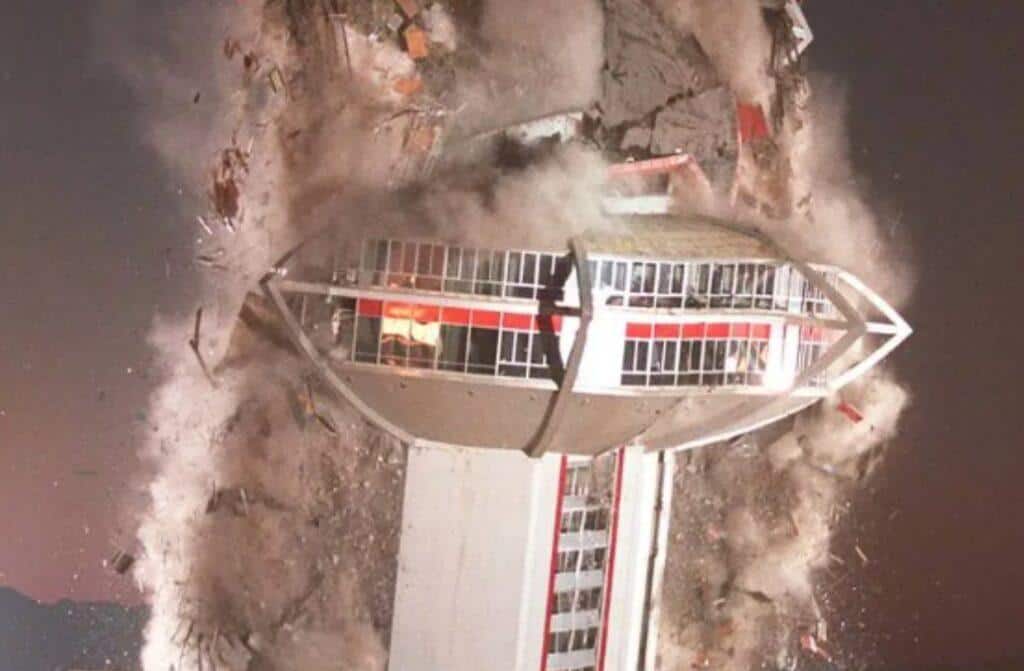
The Landmark Casino Implosion Las Vegas
The Landmark Casino, a once-prominent establishment that graced the renowned Las Vegas Strip, boasts a captivating history of its rise to prominence, a turbulent journey under various owners, and a collection of mysterious dark secrets that eventually led to its dramatic implosion. Join us as we embark on a journey to uncover the intriguing story of The Landmark Casino and delve into the enigmatic secrets that surround its legacy.
The Beginnings
In 1969, The Landmark Casino made its debut as a modern and luxurious resort, aiming to stand out in the competitive Las Vegas gaming industry. Developed by eccentric billionaire Howard Hughes, The Landmark’s iconic design featured a space-age theme, complete with a towering tower and a futuristic aesthetic that captured the imagination of visitors.
Howard Hughes’ vision for The Landmark was to create a state-of-the-art destination that showcased the latest advancements in technology and entertainment. The casino boasted cutting-edge amenities, extravagant performances, and a prime location on the Strip, attracting both locals and tourists seeking the glitz and excitement of Las Vegas.
Ownership Changes
Despite Howard Hughes’ ambitious vision, The Landmark Casino faced financial challenges and struggled to achieve its full potential. Hughes’ departure from active management left the resort in the hands of various corporations and investors, each endeavouring to revitalize its fortunes.
The Implosion
In 1995, beset by ongoing financial struggles and unable to compete with the newer mega-resorts on the Strip, The Landmark Casino met a fate similar to many of its predecessors – implosion. In a controlled demolition, the once-glamorous establishment was brought down, marking the end of an era.
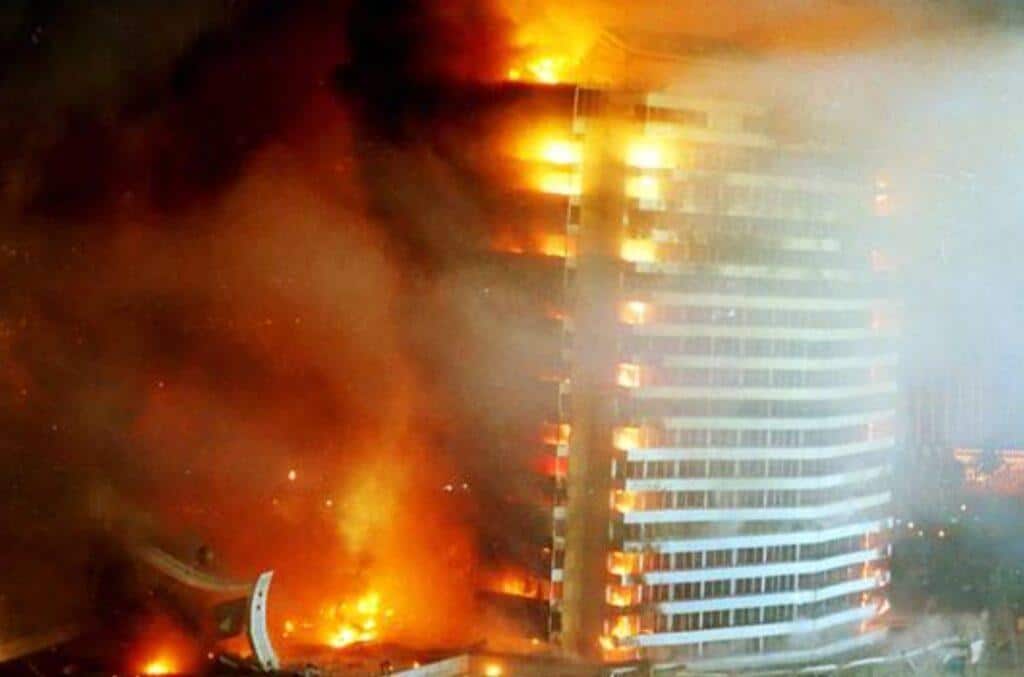
The Dunes Casino Implosion
The Dunes Casino, a historic and celebrated establishment that once stood proudly on the vibrant Las Vegas Strip, holds a captivating history of its rise to fame, a tumultuous journey under various owners, and a shroud of mysterious dark secrets that ultimately led to its dramatic implosion. Join us as we embark on a journey to uncover the intriguing story of The Dunes Casino and delve into the enigmatic secrets that surround its legacy.
The Beginnings
In 1955, The Dunes Casino opened its doors, setting the stage for an era of glamour and opulence on the famed Las Vegas Strip. Spearheaded by visionary developer Major Riddle and financed by a group of Hollywood celebrities, The Dunes boasted a distinctive Arabian Nights theme, complete with exotic architecture and lavish amenities.
The casino’s prime location and luxurious offerings, including top-notch entertainment acts and a spacious gaming floor, made it an instant hit among high-rolling gamblers and A-list celebrities. The Dunes quickly became a symbol of the Las Vegas allure, attracting visitors from around the world seeking the thrill of Sin City.
Ownership Changes
As with many casinos on the Strip, The Dunes experienced multiple changes in ownership over the years. Major Riddle’s control of the casino was short-lived, and The Dunes passed into the hands of various corporations and investors, each aiming to leave their mark on the resort’s history.
While some owners invested in renovations and expansions, others faced financial struggles and mismanagement, impacting the casino’s reputation and success. Despite these challenges, The Dunes continued to captivate guests with its unique charm and entertainment offerings.
While some of these rumours remained unconfirmed, others were substantiated by investigations and historical accounts. The cloud of suspicion surrounding The Dunes contributed to its challenges in maintaining a reputable image and financial stability.
The Implosion
In 1993, facing financial difficulties and unable to compete with the newer mega-resorts that dominated the Las Vegas Strip, The Dunes Casino met the same fate as many of its predecessors – implosion. In a controlled demolition, the iconic resort was brought down, bidding farewell to an era of elegance and nostalgia.
The implosion paved the way for future developments on the Strip, marking the end of The Dunes’ chapter in Las Vegas history. However, the memories and stories of its heyday continue to endure in the annals of the city’s rich past.
The Dunes Casino’s story is one of splendour, challenges, and the veil of dark secrets that surrounds its legacy. As we explore its fascinating beginnings, tumultuous history under various owners, and the allure of its enigmatic past, we gain insight into the ever-changing world of Las Vegas gaming and entertainment.
The implosion of The Dunes symbolizes the perpetual evolution of the Las Vegas Strip, where old gives way to new, and the spirit of reinvention remains constant. The legacy of The Dunes lives on in the memories of those who experienced its magic, forever etched in the storied tapestry of Las Vegas’ illustrious past.
Las Vegas History:
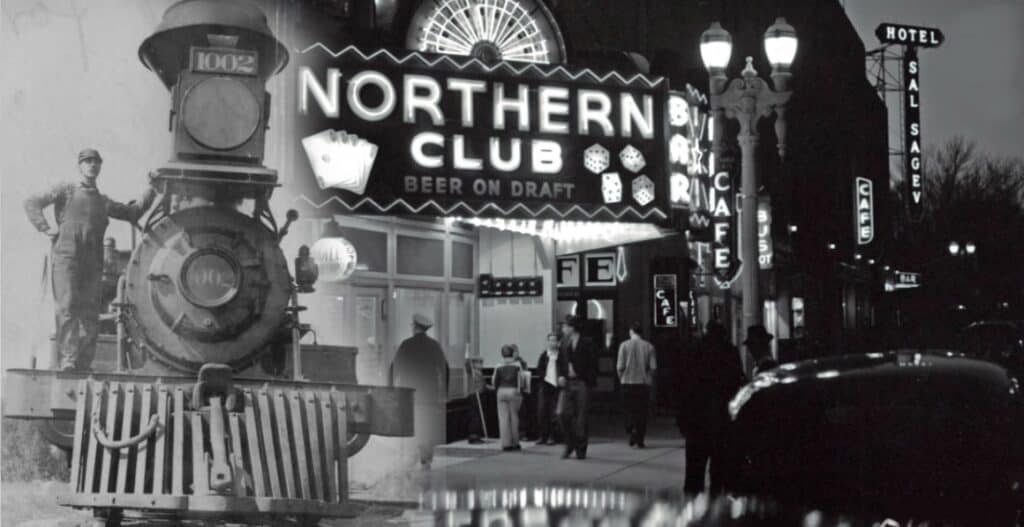
Las Vegas History: Railroad Development Paved the Way for Las Vegas to Become the Gambling Capital of the World
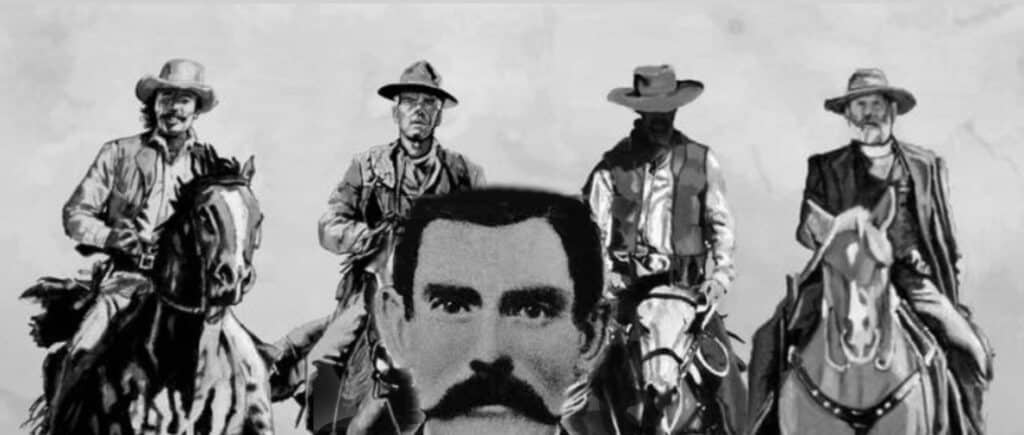
Las Vegas History: Doc Holliday Famous Gambler Gunslinger and Resident of Las Vegas
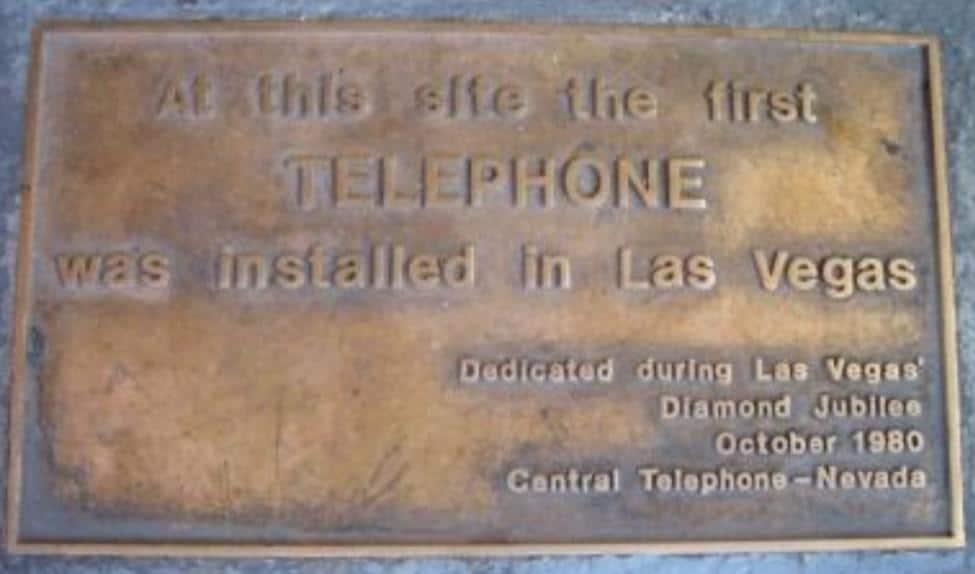
Las Vegas History: How Las Vegas’ First Telephone Exchange Made Bugsy Siegel’s Race Wire Possible

Las Vegas History: The Official Naming of Las Vegas 1905
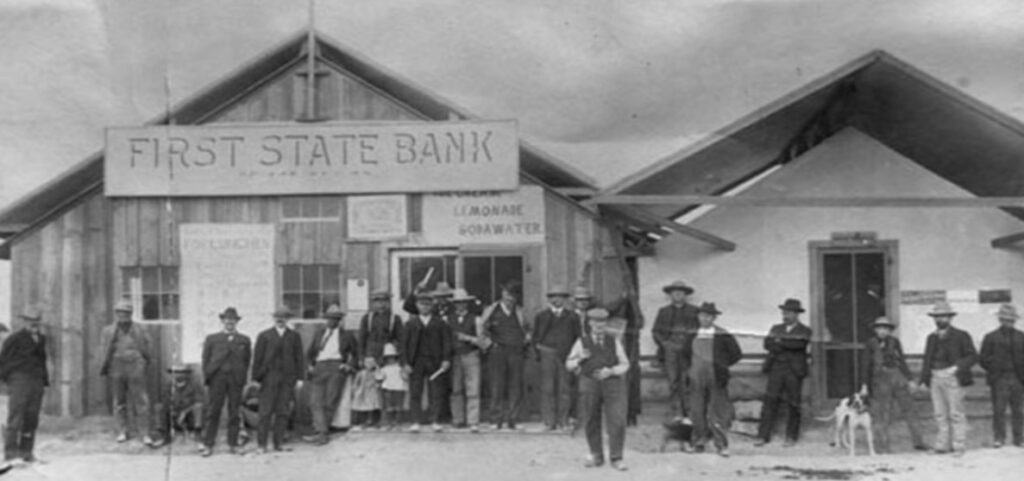
Las Vegas History: 1864 Las Vegas The Impact of Nevada Statehood
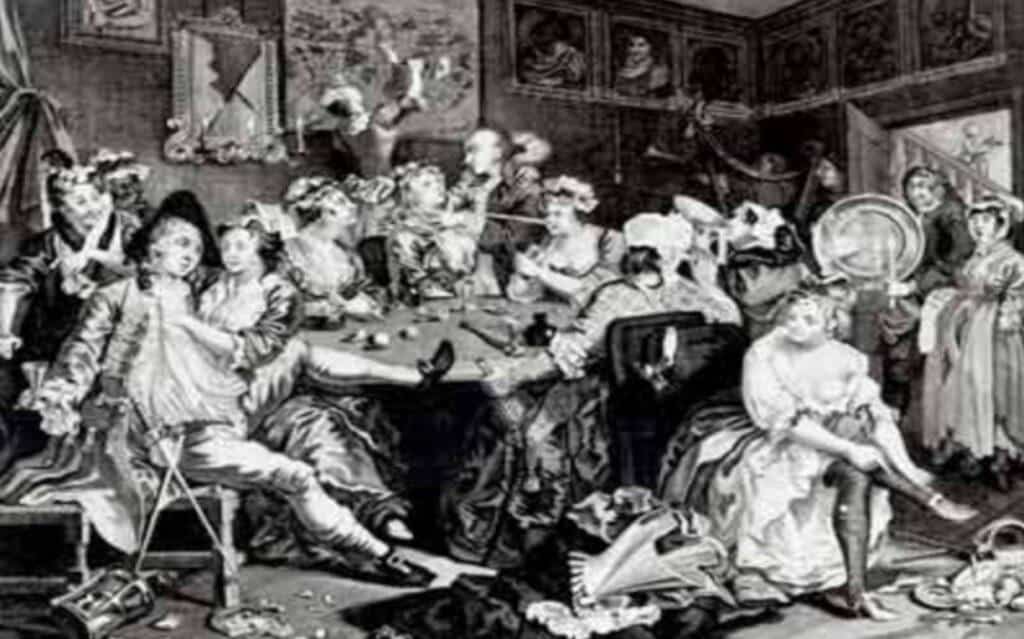
Las Vegas History: Las Vegas and It’s Vices in the 1850s
Frequently Asked Questions (FAQs) Casino Implosions:
1. What is a casino implosion?
A casino implosion refers to the controlled demolition of a casino building, typically done to make way for new construction or redevelopment projects.
2. Why are casinos in Las Vegas often imploded?
Casinos in Las Vegas are imploded to make room for newer, more modern resorts and attractions, as the city continually evolves and upgrades its offerings to attract tourists.
3. How are casino implosions conducted?
Casino implosions are carefully planned and executed by demolition experts using strategically placed explosives to bring down the building in a controlled manner, minimizing damage to surrounding structures.
4. Which Las Vegas casinos have been imploded in the past?
Some notable Las Vegas casinos that have been imploded include the Dunes, the Sands, the Stardust, and the Riviera, among others.
5. What factors determine whether a casino is chosen for implosion?
Factors such as age, condition, location, and market demand play a role in determining whether a casino is selected for implosion.
6. How does the implosion process impact the Las Vegas skyline and tourism?
The implosion of iconic casinos often attracts media attention and serves as a spectacle for tourists, contributing to the dynamic nature of the Las Vegas skyline and enhancing the city’s reputation as an entertainment destination.
7. Are there any environmental concerns associated with casino implosions?
While implosions are designed to minimize environmental impact, measures are taken to control dust, debris, and noise pollution during the demolition process.
8. What happens to the debris after a casino implosion?
Debris from casino implosions is typically cleared and disposed of in accordance with environmental regulations, with efforts made to recycle materials whenever possible.
9. How long does it take to prepare for a casino implosion?
Preparation for a casino implosion can take several months to years, involving meticulous planning, permitting, and coordination with various stakeholders.
10. Are there any plans for future casino implosions in Las Vegas?
Plans for future implosions in Las Vegas depend on market conditions, development projects, and the evolving landscape of the city’s tourism and entertainment industry. While specific implosions may not be announced in advance, the possibility of future demolitions remains a part of Las Vegas’s ongoing transformation, but the Tropicana is said to be next and will mark the first one in over a decade making room for the Las Vegas A’s New Stadium.





